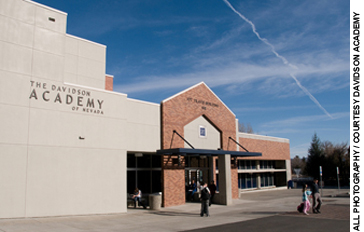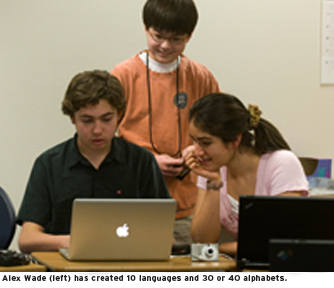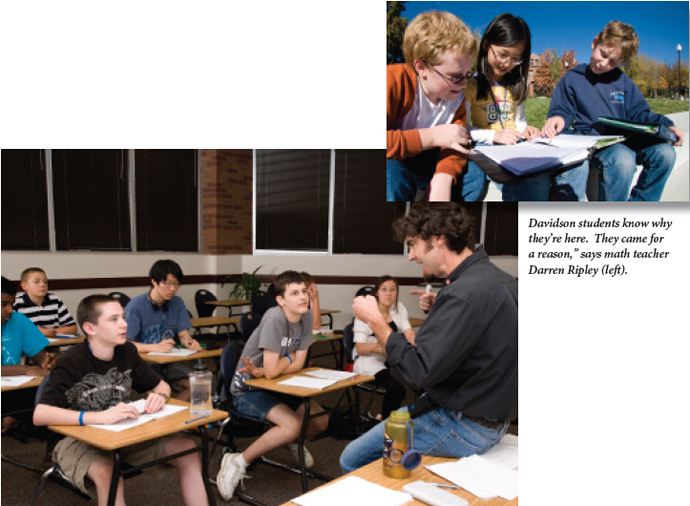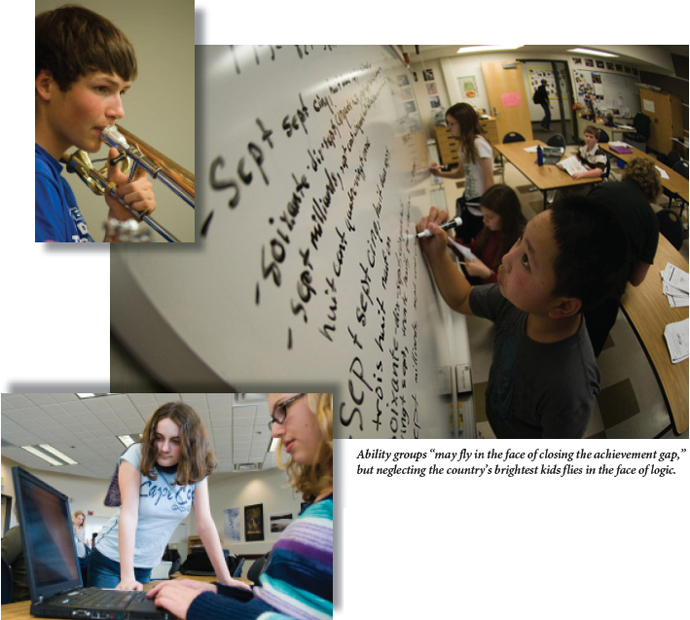Additional photographs of the Davidson Academy are available here.
 Alex Wade’s field is linguistics. In his search for the perfect language—and “annoyed,” he says, with Esperanto—he has created 10 languages and 30 or 40 alphabets, including one language without verbs, just for the challenge. He’s taking courses at the University of Nevada, Reno, in Basque, linguistics, and microbiology (because he also has a talent for science). And there’s this: Alex is 13.
Alex Wade’s field is linguistics. In his search for the perfect language—and “annoyed,” he says, with Esperanto—he has created 10 languages and 30 or 40 alphabets, including one language without verbs, just for the challenge. He’s taking courses at the University of Nevada, Reno, in Basque, linguistics, and microbiology (because he also has a talent for science). And there’s this: Alex is 13.
Taylor Wilson’s field is nuclear chemistry. He has developed a process to detect weapons-grade nuclear material and chemical-warfare agents in shipping containers, a project that has interested the U.S. Department of Homeland Security. He spent part of the summer at the Large Hadron Collider in Switzerland, and is now at work on a process to cut the production cost of radioactive isotopes. “I think it has promise,” he says. Taylor is 16.
What’s a school to do with youngsters like Alex Wade and Taylor Wilson, kids who are intellectually years ahead of their age group, their textbooks, the curriculum, and usually their teachers?
When the National Association for Gifted Children (NAGC) surveyed states in 2008 about what they provide in the way of gifted education, it found the answer to be “not much.” At least a dozen states don’t let children start kindergarten early, even if they’re already reading The Aeneid. Two states bar a middle schooler from taking high-school classes. At least 30 states allow only those in 11th and 12th grade to also enroll in college classes. And almost no one will waive mandatory-attendance laws for the 15-year-old who has gotten everything she can out of her high school and itches to move on.
“That’s a mistreatment of students,” says Bob Davidson who, with his wife, Jan, founded, developed, and then sold the company that marketed the hugely successful Math Blaster and Reading Blaster computer software. So, in 2006, the Davidsons started a public school—a public school like no other—on the University of Nevada campus.
The Davidson Academy accepts only youngsters with an IQ of 145 or higher. That puts the 123 kids enrolled here, including Alex Wade and Taylor Wilson, in the 99.9th percentile of their age group. Or as Bob Davidson says, “The likely people to make the big discoveries” in the next generation.
Katie Daw, at age 14, resorts to exasperated sighs to describe her schooling before the Davidson Academy. By 2nd grade, her private-school curriculum wasn’t challenging her, but administrators wouldn’t let her join a math class with older kids. In 3rd grade, she tried home schooling, using 5th- and 6th- grade curricula, but she finished a day’s lessons in 90 minutes. She tried another private school that let her skip a grade, but then “the excluding began,” she says. Why? “I asked a lot of questions,” she replies.
None of that story is particularly unusual, experts in gifted education told me. “For a really bright kid, it would be pretty difficult” to find much challenge in a regular classroom, said Nicholas Colangelo, director of the Belin-Blank Center for Gifted Education and Talent Development at the University of Iowa.
Part of the reason is that even the best school districts struggle with youngsters at the outer edges of the learning continuum. Researchers generally divide truly bright kids into four categories: gifted learners score above 130 on IQ tests, the highly gifted score above 145, the exceptionally gifted above 160, and the profoundly gifted above 175.
By those definitions, Miraca Gross, a professor of gifted education at Australia’s University of New South Wales, calculates that a teacher may encounter a gifted child only every few years. The odds of encountering an exceptionally gifted child during an entire 40-year teaching career are about 1 in 80. Teachers aren’t trained to teach that once-in-a-blue-moon student; they’re taught to accommodate the two-thirds of us who have IQs that fall between 85 and 115, or one standard deviation on either side of 100, the norm.
The bigger issue is whether schools even try to accommodate gifted learners, and researchers in gifted education make it clear that they don’t. Americans are awed by geniuses, especially technology giants like Bill Gates and Mark Zuckerberg, whose youthful ideas created entire new industries.
But we’re uncomfortable with the idea of singling out a few kids for special treatment. Our discomfort rises if those kids are suburban whites who already have access to the best schools and widest opportunities. We assume they will learn by themselves (although research suggests that they don’t), or that they have parents who can afford tutors and private lessons to keep them engaged. We’re even more uncomfortable with the idea of grouping youngsters by ability, especially because research suggests that the bright kids in a classroom help pull up the slower learners. “We rub our hands about elitism. It’s the single most difficult nut to crack” in gifted education, Tracy Cross, director of William and Mary’s gifted-education center, told me.
Federal education policy plays into the egalitarian sentiment by prodding the states to narrow the achievement gap between their lowest and highest performers. Since 2000, the gap in reading scores between the highest- and lowest-performing 10 percent of 4th graders has narrowed to 90 points from 103 points on the National Assessment of Educational Progress. The results are similar in 8th-grade math.
But that has happened largely because the scores for the brightest kids have barely moved. “Our gifted kids are stagnant,” said Ann Robinson, a professor of gifted education at the University of Arkansas. “When you’re trying to get everybody to proficient, [the ablest learners] are not going to be the policy focus.”
What little attention the brightest do receive may be diminished even more in these tough economic times. In the 2008 NAGC survey of state policies, 18 states reported they don’t provide any money for gifted education, and 7 others noted they fund it only if they have money to spare. The federal government funds just one $7 million program in gifted education, and appropriations panels in both the Senate and House voted preliminarily this past summer to eliminate even that. Funding gifted education is thus left largely up to school districts, which are hard hit by falling property taxes and looking to cut budgets without reducing the number of kids who get over the minimum-proficiency bar.
Cross, Colangelo, and Robinson all argue that the U.S. should be fanning the learning gap by teaching every youngster to his potential, rather than narrowing it by ignoring youngsters who have reached state minimums. Not because slower learners shouldn’t be helped, they argue, but because faster learners shouldn’t be kept waiting.
Indeed, Cross told me that as part of a research project he once asked 13,000 kids in seven states to describe in one word their experience as gifted children. The most commonly used word, he says, was “waiting.” Waiting for teachers to move ahead, waiting for classmates to catch up, waiting to learn something new—always waiting.
Meet the Davidsons
Bob Davidson says he had his epiphany after reading a newspaper story about a Maryland child who was assigned to kindergarten, even though he had the reading skills of an 11th grader. “Think of that,” says Davidson, slipping into the voice of an imaginary principal lecturing an imaginary parent, “‘We have this rule and you’re not in a position’” to challenge it.
Davidson, at age 67, is tall, gray-haired, fast-talking, and faster moving (his hobby is driving race cars). He earned degrees in chemical engineering, business, and law, and was executive vice president of an engineering concern before becoming CEO of the software company his wife founded. Jan Davidson, who is 66, has a PhD in American studies and is small, blond, and motherly: On a visit to the academy, she busily hugged students in the few minutes between classes. She came up with the idea for the Blaster programs after realizing, in the 1970s, the potential for computers to individualize instruction, she says.
After selling their company in 1997, the Davidsons said they spent two and a half years reading education research and looking for a way to get involved in school reform. Retired to Lake Tahoe, just outside Reno, they decided that gifted education fit their bill: The gifted population was small enough that they could have an effect (people with an IQ above 145 account for 0.13 percent of the population).
It was a group undoubtedly underserved: The federal government requires schools to provide an appropriate education to children with cognitive, physical, and emotional handicaps, but is largely silent about the needs of kids at the upper end of the educational curve. “And importantly to us, this is a population that could give back to society in their adulthood,” Jan Davidson told me.
The Davidsons first launched a young scholars program to provide tutoring and advocacy help for gifted youngsters trying to fight their way through school bureaucracies (the program now is funding 1,700 scholars). They followed that with a summer program that invites youngsters to attend UNR classes for credit. They wrote a book on gifted education, funded research, and awarded college scholarships.
But parents kept asking for a school, and said they would move wherever the Davidsons built it. In 2005, the couple convinced the Nevada legislature to let them launch a public school for what the legislature called the “profoundly gifted” on the Reno campus. The legislation didn’t exempt the Davidson Academy from state reading and math tests or core-curriculum requirements; it didn’t provide any funding, either.
The Davidsons paid the full cost of the school—for 35 kids the first year, 44 the second—until the legislature met again, two years later, and included the academy in the state funding formula. That amounts to $6,439 per student this year, or about $2,000 less, on average, than at other Nevada public schools, which receive money from federal poverty and special-education programs.
The Davidsons pick up the rest of the $18,918 per-student tab. Among other costs, that includes UNR tuition (about one-quarter of Davidson students take UNR classes) and a stipend for chaperones to walk the younger children to and from their university classrooms. In return for an $11 million donation to a new math and science center that bears the Davidsons’ names, the university turned over part of its former student union to the Davidsons, who spent $4 million refitting it with classrooms.
A 145 IQ score gets you an invitation to apply to the academy, but a grueling all-day assessment gets you in. This year, the school took in 39 new students and turned away 50 others. Many of the youngsters are Nevadans, including those whose parents came looking for jobs in Nevada’s boom days or retired to the Silver State. But about 41 percent of students have moved with their families to Nevada, the epicenter of the nation’s housing and employment bust, just to attend the academy.
That’s one reason for a demographically skewed student body (there’s one African American and one Hispanic). The relocation is out of reach for low-income families, those stuck with unsellable houses, and those who can’t find a job in Reno. The academy plans to start a residential program next year, but out-of-state parents will have to pay tuition, room, and board.
The Academy
When I visited the Davidson Academy, three weeks into the fall semester, teacher Alanna Simmons’s critical-theory class already had tackled Henry Louis Gates, Harold Bloom, Edward Said, and now was cheerfully plowing though a printout of a dense Jean-Paul Sartre essay on literature.
There was general bemusement at Sartre’s reference—famous in philosophy circles—to “horses of butter,” and knowing nods when one student quoted Albert Camus insulting Sartre. At Simmons’s request, the nine students, aged 12 to 17, rushed to the white board to record their favorite Sartre quote, and then excitedly dissected each one. “It smells like didactic rhetoric,” someone piped up at one point.
I noticed Daniel Hickox-Young, who is 17 and the school jock, smiling broadly and later I asked him why. “It’s so cool,” he said of literature theory.
Carmen Garcia, the academy’s director of curriculum, teacher training, and admission, told me this is a fairly typical class. The school uses few textbooks because classes move too quickly—“No textbook is going to fit the bill for more than two weeks,” she said—and because students prefer the variety of perspectives that come from reading original sources. “A history textbook; it’s doomed here,” she added.
Classes are grouped by ability rather than age, and Garcia and the teachers devote the first weeks of the school year to assessing each student in each core subject, moving him or her up or down a subject level to assure the best classroom fit. When an American history and government class broke into groups to discuss Aztec leadership, I noticed that a 12-year-old girl in striped knee socks was grouped with a 16-year-old boy who needed a shave. The 12-year-old was more than holding her own.
Davidson classes are small, typically eight or nine students. But this year’s advanced physics class has just two pupils. When Katie Daw at age 10 proved herself too advanced for Algebra 1, but not quite ready for Algebra 2, Davidson gave her a math tutor for the year.
Teachers told me they seldom lecture. “If we try to lecture, these kids are going to get bored,” said Darren Ripley, who has a 10-year-old in one of his calculus classes, a girl he refers to as “a big mind.” Instead, teachers seem to ride the wave of classroom discussion, now and then dipping in a navigational oar. “Sometimes you have to let go and see what’s working at the moment, then try to reel it back,” said Jessica Juriaan, who teaches British and American literature.
Davidson teachers are paid on the same scale as other Reno teachers—from about $45,000 to $67,000 a year—but aren’t union members, don’t get tenure, and aren’t even public employees. Ripley, who is 40, and Juriaan, who is 29, previously taught in Reno public schools and at UNR. Both are working on PhDs, and bristle with energy. I asked them to describe the difference between the Davidson youngsters and their public-school peers.
Juriaan said she teaches the standard literature curriculum, but that her Davidson classes focus on analysis; in her public-school classes, she spent her time helping students comprehend the plot. When I visited her class, her 11 students, aged 12 to 15, were discussing scapegoating and hysteria (Was the Spanish Inquisition a witch hunt? what about the Crusades? the Trail of Tears?) in anticipation of reading The Crucible.
Ripley, who sports a goatee and treats calculus like wicked fun, talked about “the motivation and level of buy-in” among the Davidson kids. “They know why they’re here. They came for a reason,” he said.
No Easy Answer
What does this all mean for the thousands of other gifted students around the country? Tracy Cross and Nicolas Colangelo both told me they doubt that profoundly gifted students can be accommodated in the typical public-school classroom: Like profoundly challenged children, they may need special classes, teachers, and even schools that adapt to their differences.
Davidson’s communications director, Julie Dudley, said the academy receives so many e-mails asking how to start a gifted school that she has worked up a form-letter reply. Most promoters lose interest when they learn they’ll need legislative exemptions to many state education laws, she said. There’s no seat-time requirement at Davidson, for example: Students typically finish seven years of middle and high school in five years.
I asked Davidson teachers and staffers what lessons public schools could take away from the academy. Their answers struck me a lot like the idea of getting rid of seat-time laws: logical, good for kids, and political showstoppers.
• Allow youngsters to accelerate by subject. Colleen Harsin, the academy’s longtime director, proposed that a school group its core classes—hold all math classes during 2nd period, say; all English during 3rd—so students can move up or down according to their ability.
• Promote dual enrollment so youngsters can take classes in both elementary and middle school, middle and high school, high school and college. That may strain transportation budgets, but students will graduate sooner, offsetting the costs.
• Individualize learning. Davidson students each have a learning plan that’s refined during weekly meetings with their advisors, semester meetings with Garcia, and yearly what’s-next meetings with Harsin. That might strain a school of 2,000, but so do discipline problems caused by bored or out-of-their depth youngsters.
• Group students by ability, not age. “You can’t teach to the middle,” Ripley said. “To say we’re all at an Algebra 2 level just isn’t accurate.”
That’s Bob Davidson’s mantra: Ability grouping “may fly in the face of closing the achievement gap,” but neglecting the country’s brightest kids flies in the face of logic. “Don’t stop them,” he says.
June Kronholz is a former Wall Street Journal foreign correspondent, bureau chief, and education reporter, and currently a contributing editor at Education Next.
This article appeared in the Spring 2011 issue of Education Next. Suggested citation format:
Kronholz, J. (2011). Challenging the Gifted: Nuclear chemistry and Sartre draw the best and brightest to Reno. Education Next, 11(2), 32-39.






